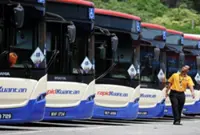Nor Hisham Zulkiflee wearing a WW2 era military uniform and walking along on the Kuala Dipang Iron Bridge on Dec 29, 2021—RONNIE CHIN/The Star
KAMPAR: Plans are in motion to list the Kuala Dipang Iron Bridge, a strategic location during World War II, as part of the Kinta Valley Geopark site.
Perak State Park Corporation officer Ain Maisyara Yazrol said the site would be included under the Geopark’s historical and cultural listing.
Already a subscriber? Log in
Save 30% OFF The Star Digital Access
Cancel anytime. Ad-free. Unlimited access with perks.





